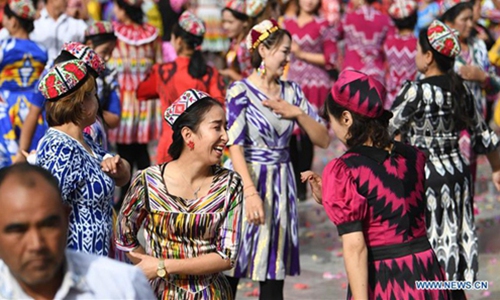HOME >> OPINION
US won’t succeed in driving a wedge between China and Central Asia
By Yu Jincui Source:Global Times Published: 2020/1/1 20:15:58

People dance at a square during a culture and tourism festival themed on Dolan and Qiuci culture in Awat County of Aksu Prefecture, Northwest China's Xinjiang Uyghur Autonomous Region on October 25. Phont:Xinhua
The latest target of the US attempt to sow discord over China's policies and measures in the country's Xinjiang Uyghur Autonomous Region is Central Asia. US Secretary of State Mike Pompeo is set to visit Kazakhstan and Uzbekistan during a five-nation tour of Europe and Central Asia from Friday to Tuesday. According to media reports, the top US diplomat will raise Xinjiang-related issues in bilateral talks and a ministerial meeting of five Central Asian countries plus the US (C5+1) during his trip as the US has not "seen any kind of significant improvement in the situation there."
The visit comes amid an ongoing smear campaign launched by the US against Xinjiang's counter-terrorism and de-radicalization efforts. For quite a while, the US has been ceaselessly attacking China's Xinjiang governance and inciting countries and regions globally to criticize the Chinese government on its Xinjiang policy. However, people can tell right from wrong. A group of 50 countries signed a letter in July 2019 to the UN Human Rights Council and the Office of the UN High Commissioner for Human Rights, voicing support for China's governance in Xinjiang, among which were Central Asian countries Tajikistan, Turkmenistan and Uzbekistan.
Affairs concerning Xinjiang are not about religion, ethnicity or human rights, but about fighting violence, terrorism and separatism - Central Asian countries adjacent to Xinjiang know the fact well and they have greatly benefited from the stability in Xinjiang. That Xinjiang has now experienced peace and development is a blessing to the whole region, particularly Central Asia. All neighboring countries and regions would have suffered if Xinjiang were still mired in turmoil triggered by terrorist attacks.
Xinjiang region and Central Asian countries are all facing the threats of the "three evil forces," namely terrorism, extremism and separatism, and they share common interests in terms of counter-terrorism. China is exploring a new way to deal with the "three evil forces" by setting up vocational education and training centers to provide trainees with courses including the country's common language, law, vocational skills and de-radicalization. The measures tackle both symptoms and root causes and have proven effective. Xinjiang has not seen a single terrorist incident for nearly three years since education and training started. The "Xinjiang model" is worthy of studying or imitating by terrorism-stricken countries such as those in Central Asia.
Nonetheless, a noticeable trend is that the US is ratcheting up attention on Central Asia. A senior US State Department official revealed in December that a new US Central Asia strategy would soon be published. Although so far Washington hasn't increased any tangible inputs into the region, Pompeo's upcoming Central Asia trip indicates that the US is going to play an ideological card to drive a wedge between China and Central Asia. China has to be vigilant of the US attempt to fuel antipathy against it in Central Asia by smearing China's counter-terrorism efforts as "Muslim repression."
The Central Asian countries also need to see through the US plot. Mutually supporting each other in terms of counter-terrorism and deepening cooperation between China and Central Asia is in line with all sides' interests. The good momentum of mutual trust and cooperation won't, and shouldn't, be impeded by the US. China-Central Asia cooperation is aimed at a more important and greater goal, that is, common development.
Newspaper headline: US won’t drive wedge between China and Central Asia
Posted in: OBSERVER